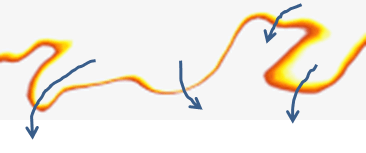Flamelet
Flamelet models avoid the computational expense of complex chemistry calculations by pre-calculating the chemistry in gas-phase laminar flames using simple 0D or 1D geometries with detailed chemical mechanisms. A reduced set of variables are used to parameterize and tabulate the species from these simple flames, which are then interpolated in the 3D simulation of turbulent flames in Simcenter STAR-CCM+.
In the following diagram, the dark area shows a thin reaction front in which reactions happen faster than turbulent mixing. Intermediate species do not exist for long enough to be transported out of the reaction front by turbulent mixing.

All Flamelet models in Simcenter STAR-CCM+ use mixture fraction as one parameter. The mixture fraction is defined as the atomic (or elemental) mass fraction that originated from the fuel stream. For combustors with one fuel and one oxidizer stream, if all species diffuse at the same rate—a good assumption for turbulent flows—you can define one unique mixture fraction. Since atomic elements are conserved in chemical reactions, the mixture fraction is conserved and therefore the corresponding transport equation does not have a source term.
- Flamelet Generated Manifold (FGM): generally the most accurate flamelet model.
- Steady Laminar Flamelet (SLF): only better than FGM for some highly strained non-premixed flames.
- Chemical Equilibrium: least accurate flamelet model, but is straightforward to use when you do not have a mechanism, or when the combustor is large.
The Chemical Equilibrium and SLF models are best-suited for turbulent diffusion (non-premixed) flames. However, you can apply Flamelet models to partially premixed and even perfectly premixed flames by combining a Flamelet model with a flame position model. See Flame Propagation.
For guidance on which of the combustion models are best for a selection of applications, see Combustion and Other Reacting Flows in Simcenter STAR-CCM+.
A few parameters, such as mixture fraction, reaction progress, scalar dissipation, and enthalpy, are used to parameterize the thermochemical state (species composition and temperature) of the system. Since the number of parameters are small, it is feasible to use presumed Probability Density Functions (PPDF) to account for fluctuations. A Beta function approximates the distribution of mixture fraction as it is a conserved scalar. The Beta function requires a variance, or second moment, which can be solved from a transport equation in RANS and an algebraic expression in LES. The Flamelet models use beta PPDF functions for mixture fraction, and delta functions for the other parameters such as enthalpy and scalar dissipation.
You use Flamelet models for gas-phase flames where the thermo-chemistry occurs near the flamelet manifold. For example, in statistically steady, constant pressure combustors, such as gas-turbines at full power.
Flamelet Generated Manifold Model
- High Damkohler-number zones, where reaction zones are thin.
- Low Damkohler-number zones, where reaction zones are diffuse. However, this model does not capture slowly forming pollutants.
- Premixed and partially premixed flames.
To initiate flame ignition, the FGM model provides the Progress Variable Ignitor. Access this ignitor by right-clicking the node. When active, a Progress Variable Ignitor applies its specified progress variable value to the cells that are contained within the ignitor parts. When inactive, this ignitor does not affect the value of the progress variable.
Chemical Equilibrium Model
- fuels for which a chemical mechanism is not available
- combustors where the residence time is large enough that the thermo-chemistry is near chemical equilibrium—for example, in fires
Steady Laminar Flamelet Model
The Steady Laminar Flamelet (SLF) model solves 1D opposed-flow diffusion flames and parameterizes species by mixture fraction and scalar dissipation, which corresponds to the strain (compression) of the opposed flow flame. The SLF model embeds these opposed-flow flames in the CFD turbulent flame brush and assumes that the local turbulent flow field compresses the flamelets. The chemistry is assumed to be fast and therefore responds to the local turbulent strain instantaneously. However, it is not possible to model extinction or ignition with the SLF model.
Since a non-premixed flame is resolved, the SLF model is suitable for modeling steady state diffusion combustion, such as in non-premixed furnaces and burners.
Flamelet Tables
You can create flamelet tables for each of the flamelet models within Simcenter STAR-CCM+.
See Flamelet Tables.